INTRODUCTION TO TAXONOMY
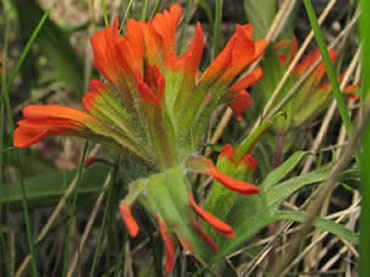
Castilleja miniata, photo by Werner Eigelssreiter
What is Taxonomy and Where Did it Originate?
by
Jamie Fenneman
Taxonomy is the method by which scientists, conservationists, and naturalists classify and organize the vast diversity of living things on this planet in an effort to understand the evolutionary relationships between them. Modern taxonomy originated in the mid-1700s when Swedish-born Carolus Linnaeus (also known as Carl Linnaeus or Carl von Linné) published his multi-volume Systema naturae, outlining his new and revolutionary method for classifying and, especially, naming living organisms. Prior to Linnaeus, all described species were given long, complex names that provided much more information than was needed and were clumsy to use. Linnaeus took a different approach: he reduced every single described species to a two-part, Latinized name known as the “binomial” name. Thus, through the Linnaean system a species such as the dog rose changed from long, unwieldy names such as Rosa sylvestris inodora seu canina and Rosa sylvestra alba cum rubore, folio glabro to the shorter, easier to use Rosa canina. This facilitated the naming of species that, with the massive influx of new specimens from newly explored regions of Africa, Asia, and the Americas, was in need of a more efficient and usable system.
Although trained in the field of medicine, botany and classification were the true passions of Linnaeus and he actively explored northern Europe and described and named hundreds of new plant species during his lifetime. As well, Linnaeus spent a great deal of time describing and naming new plant specimens that were sent to him from around the world by other botanists, including from the newly explored regions of the New World. Linnaeus classified this multitude of new plant species based upon their reproductive structures, a method which is still largely in use today. In fact, the majority of the species described by Linnaeus are still recognized today, indicating how far ahead of his time he truly was. Although somewhat rudimentary by today’s standards, Linnaeus’ methods of describing species in such a way as to represent the relationships between them changed the face of taxonomy and allowed biologists to better understand the complex natural world around us.
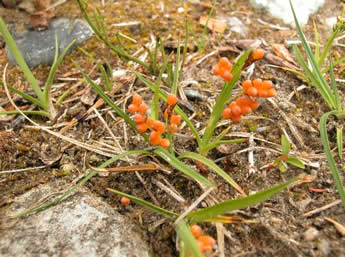
Carex aurea, photo by Adolf Ceska
How Do We Classify Plants?
Plants, and indeed all organisms, are classified in a hierarchical system that attempts to illustrate the evolutionary relationships between the various groupings within the hierarchy. This concept of relatedness forms the backbone of modern classification schemes. Scientists who attempt to classify organisms and place them within an evolutionary framework are called Taxonomists, the most famous of which would be Linnaeus himself. At the broadest level, all organisms on the planet are classified into 5 Kingdoms: Animalia (animals), Plantae (plants, some multicellular algae), Fungi (fungi), Monera (prokaryotic bacteria), and Protista (eukaryotic bacteria, most algae, etc.), representing the most ancient branches of the evolutionary “tree of life.” Organisms in any given Kingdom may be separated from organisms in any other Kingdom by many hundreds of millions, if not billions, of years of evolution. Historically, all organisms known were grouped into only two Kingdoms: organisms that had finite growth, moved, and ate were grouped into the Kingdom Animalia, while organisms that had indefinite growth, didn’t move, and didn’t eat were grouped into the Kingdom Plantae. Of course, as science progressed, it became increasingly evident that such a simplistic approach to taxonomy was ineffective and many species were found that did not fit either grouping particularly well. The proposal to move to an eight-Kingdom system suggests that our current classification system, with its five Kingdoms, may yet change again as our understanding of the diversity of organisms around us continues to grow.
Within each Kingdom, the organisms are grouped into several Phyla (sing. Phylum), also known as Divisions, which represent smaller groupings of more recognizable forms. Although the Kingdom Animalia contains a large number of Phyla (such as chordates [including vertebrates], echinoderms, annelids, arthropods, etc.), Kingdom Plantae contains only ten. The Phylum Bryophyta (mosses, liverworts, hornworts), the most primitive of all true plants, differs from other plant Phyla in that it is non-vascular, meaning that it lacks water-conducting tissues which bring water from the roots of the plant up into the crown, and that the gametophyte (vegetative) generation predominates over the sporophyte (reproductive) generation. The Phyla Psilophyta (whisk ferns), Lycopodiophyta (club-mosses, spike-mosses, quillworts), Equisetophyta (horsetails), and Polypodiophyta (true ferns), including all vascular plants that reproduce using spores, also form an ancient, though largely artificial, grouping and are often referred to as Pteridophytes. The Phyla Cycadophyta (cycads), Ginkgophyta (ginkgo), Gnetophyta (vessel-bearing gymnosperms), and Coniferophyta (conifers) form a second primitive grouping of vascular plants, known as Gymnosperms, which are characterized by the presence of naked seeds (the literal translation of “gymno-sperm”). The final Phylum, Magnoliophyta, contains all of the vascular, flowering plants that are considered to be the most advanced and recently-evolved plants occurring on the planet today.
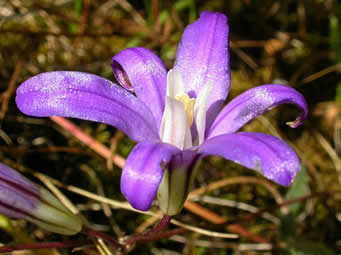
Brodiaea coronaria, photo by Dave Ingram
Within each Phylum, the organisms involved are grouped into progressively smaller, more refined groupings of similar individuals. Below Phylum, organisms are grouped into Classes, Orders, and Families, the latter being the largest-order taxonomic grouping that is commonly used by amateur botanists. As an example, the Phylum Magnoliophyta is split into 2 well-known Classes: Magnoliopsida (Dicotyledons) and Liliopsida (Monocotyledons) based on a variety of features from leaf venation and flower structure to growth form, root structure, and seed structure, each class with its subsequent Orders and Families. Each family is further divided into Genera (sing. Genus) representing organisms with similar morphology, structure, reproductive organs, and, perhaps most importantly, evolutionary history. These genera represent groupings that many of us are most familiar with, such as Rhododendron, Rosa, Chrysanthemum, etc. and are designed to illustrate that the individual organisms grouped within the same genus are very closely related to each other. In fact, the genus is the taxonomic grouping that represents the closest relationship between organisms which, at the smallest taxonomic level, are called Species. Each individual species is given a specific name that, when combined with the generic name, produces the two-term “binomial” naming system that Linnaeus pioneered. For example, within the genus Rosa are a variety of species such as acicularis, nutkatensis, and woodsii. Through the binomial naming system, these species become Rosa acicularis, R. nutkatensis and R.woodsii (the generic name is shortened to the first initial when listing several species in the same genus).
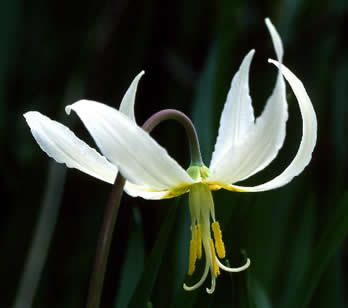
Erythronium oreganum, photo by Rod Innes
Of course, as with many scientific theories or strategies, there are problems with this system in the way it is currently applied and as a result it is in a continual state of flux, especially at the lower levels of the hierarchy. Even at the highest level (Kingdom), several groups are still cause for debate among taxonomists as to their placement. For example, how do we classify lichens? Lichens were originally placed within the Kingdom Plantae until further research showed that what we call “lichens” are actually a symbiotic relationship between certain species of fungi and certain species of algae. The two species, which can often survive independent of each other, combine to form a third plant-like “species” of organism called “lichen” that differs greatly from either of its two parent species yet functions as its own reproductive, evolutionary organism (thus meeting the criteria for a “species”). Currently lichens are included within the Kingdom Fungi since the fungal partner is the driving force behind the union (essentially “cultivating” its algal partner in order to produce its own nourishment) but this treatment still does not really fit with traditional taxonomy.
Another example of how nature continually confounds attempts to classify it is the vast array of plant-like organisms grouped under the term “algae.” The confusion results from the fact that most algae are unicellular or, if multicellular, composed of a single or very few cell types amassed together to function as a larger individual. So, do we classify multicellular algae based on the characteristics of the single cell (Protista) or as an independent multicellular organism (Plantae)? Most algae are currently placed within the Kingdom Protista despite their often plant-like appearance, with only a few of the multi-cellular forms remaining within the Kingdom Plantae. This treatment is not followed by all authors, however, as some retain all of the algae as a subkingdom within the Kingdom Plantae. Regardless of the treatment, it is obvious that the great diversity within the group “algae,” as well as its unusual morphological and cellular characteristics, is a hindrance to botanists who attempt to classify them within our current taxonomic systems.
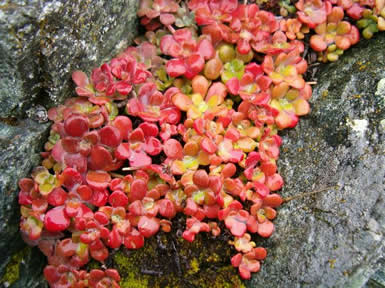
Sedum spathulifoliium, photo by Kevin Newell
What is a “Species”?
At the lowest level of the classification hierarchy is the “species”, a human-derived concept that, to this day, is still not completely understood by scientists. The general consensus in past decades has been that a “species” is a group of similar individuals which can reproduce successfully with each other while at the same time being reproductively isolated from other similar species (known as the “Biological Species Concept”). This interpretation worked reasonably well when it was first proposed, but the more we learn about ecological systems the more apparent it becomes that nature is by no means so simple. The evolutionary process is a continuum whereby a portion of the population of one entity gradually becomes more and more distinctive and discrete, eventually reaching a state in which it is reproductively isolated from its parent “species.” The infinite range of variation between the two ends of this evolutionary process means that many populations are difficult to assign to either a parent species or a new, independent species.
A newer species concept, known as the “Phylogenetic Species Concept”, attempts to give specific status to any identifiable populations that have a unique evolutionary history and differ collectively in some characteristics from other populations. This system, which places more weight on the evolutionary process and genetic differences between populations, naturally results in a far greater number of recognizable species than the more conservative Biological Species Concept. In truth, however, neither of these widely accepted concepts appears to fully represent the extraordinary complexities of the natural world, and perhaps the most effective current method of species classification is a combination of both systems.
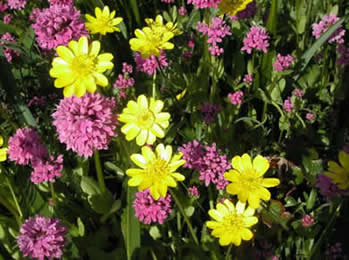
<Ranunculus californicus and Plectritis congesta, photo by Adolf Ceska
Subspecific Taxonomy
Another method used by taxonomists to deal with the variation within species is the use of “infraspecific” or “subspecific” taxonomy. Many species are not uniform in appearance throughout their distribution, and by assigning subspecies and varietal names to the identifiable populations scientists are able to catalogue and name this variation.
Populations that are approaching species status are typically categorized as subspecies (often written as “ssp.” or “subsp.”), especially when these forms have discrete geographic distributions. For example, in the species Salix reticulata (net-leaved willow) individuals occurring throughout the mountain ranges of the interior of the province with hairy capsules and a strong net-like pattern of venation on the leaves are named S. reticulata ssp.reticulata, while the populations on the Queen Charlotte Islands that have hairless capsules and a weaker net-like venation pattern on the leaves are known as S. reticulata ssp.glabellicarpa. These two subspecies have different geographic ranges and represent evolutionary lines that are fairly well defined, but are similar enough to be classed within the same species.
Links
Synonyms of Scientific Names of BC Plants
Taxonomy and Plant Identification
Links
Online
plant identification links
Plant
Identification Game
Recommended citation: Author, date, page title. In: Klinkenberg, Brian. (Editor) 2023. E-Flora BC: Electronic Atlas of the Flora of British Columbia [eflora.bc.ca]. Lab for Advanced Spatial Analysis, Department of Geography, University of British Columbia, Vancouver. [Date Accessed]
E-Flora BC: An initiative of the Spatial Data Lab, Department of Geography UBC, and the UBC Herbarium.
© Copyright 2023 E-Flora BC.